Robinson Crusoe on Mars (1964)
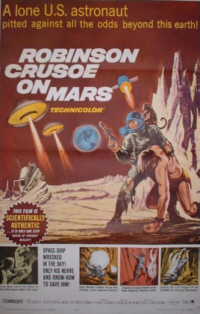
I'm not sure what Daniel Defoe would make of this modern day retelling of his
classic story, but Robinson Crusoe on Mars has all the hallmarks of a surprisingly
good film; well written, nicely acted, and boasting superior special effects,
especially the superb matt paintings by the legendary Albert Whitlock. It also
has a place in the history of The War of the Worlds, for not only was it directed
by Byron Haskin, who had previously helmed The War of the Worlds for George Pal,
but it featured some very familiar looking alien spacecraft.
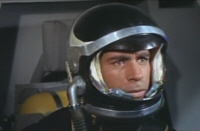 The
story begins in orbit around Mars on board an American spacecraft piloted
by Commander Christopher 'Kit' Draper (played by Paul Mantee) and Colonel Dan
McReady (an early movie role for Adam "Batman" West.) Also aboard is the
obligatory comedy monkey, Mona, here credited as the "Woolly Monkey" though in
fact its name was Barney. Dodging a large meteor, the crew are forced to eject
when their spacecraft's orbit begins to decay, but on landing they become
severely separated, The
story begins in orbit around Mars on board an American spacecraft piloted
by Commander Christopher 'Kit' Draper (played by Paul Mantee) and Colonel Dan
McReady (an early movie role for Adam "Batman" West.) Also aboard is the
obligatory comedy monkey, Mona, here credited as the "Woolly Monkey" though in
fact its name was Barney. Dodging a large meteor, the crew are forced to eject
when their spacecraft's orbit begins to decay, but on landing they become
severely separated, 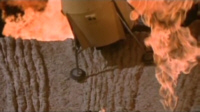 having each landed (crashed would be a much better word)
on opposite sides of a mountain range. From here on, the movie focuses
largely upon Draper's struggle for survival (though McReady does surreally
pop up one final time) as just like the titular Robinson Crusoe, he is forced
to rely on his wits and ingenuity just to keep breathing. having each landed (crashed would be a much better word)
on opposite sides of a mountain range. From here on, the movie focuses
largely upon Draper's struggle for survival (though McReady does surreally
pop up one final time) as just like the titular Robinson Crusoe, he is forced
to rely on his wits and ingenuity just to keep breathing.
Which brings us to Mars. Just what sort of world do we find in Robinson
Crusoe on Mars? One of the selling points of this movie was the boast on
both posters and in the trailer that "this film is scientifically authentic",
so how well does that claim stand up? Not fantastically well if truth be
told, but lets be charitable. To begin with, you can't exactly take the
original claim at face value; I'm sure the marketing department had a
significant hand in it. Equally, not a lot was known about Mars at the
time. Mariner 4 was still a year away and thus the movie just scraped in
before the great disappointment, when in 1965, 22 depressingly lifeless
black and white images were beamed back to Earth. It also looked pretty
certain from telescope and spectrographic analysis that the atmosphere
was far too thin to support meaningful life. To its credit, Robinson
Crusoe on Mars treads a cautious path, mindful of the need for their
star not to spend the entire movie closeted in a spacesuit, but equally,
willing to show that breathable air (and water) is a big issue.
Draper is therefore shown choking on the atmosphere when he arrives
and the clock ticking on his air supply. The atmosphere is not however
entirely inadequate to his needs, and he ekes out his supply by rationing
sniffs of his dwindling reserves, though lets be clear, no amount of
holding the breath between lungfuls would suffice on the real Mars. But
it's a pretty reasonable compromise for the movie, and Draper finally
cracks the air problem at the eleventh hour, with the accidental discovery
that a coal like substance he has been burning for warmth has a great
deal of oxygen bound up in it; again a pretty neat bit of scripting,
though you do get the impression that the air issue is then pushed to
one side, once the necessary MacGuffin is presented to the audience.
Thereafter, Draper spends more and more time without his spacesuit until
it's pretty much short-sleeves and shorts. Yet you can't deny that all
the Heath-Robinson equipment he has to build in order to maintain his
existence provides for a great deal of fun pseudo-authenticity to his
situation. The water problem is solved by Mona, who Draper observes
sneaking off on extended solo sojourns, yet never seems to get thirsty.
This results in the discovery of a large underground reservoir, and
the chance for some skinny-dipping.
 The film was shot in Death Valley National Park at a suitably blasted
place called Zabriskie Point. The superb photography combined with
Whitlock's matt painting makes for one of the best looking Martian
landscapes ever conceived, all stark colours and appallingly bleak
dust blown vistas. The film was shot in Death Valley National Park at a suitably blasted
place called Zabriskie Point. The superb photography combined with
Whitlock's matt painting makes for one of the best looking Martian
landscapes ever conceived, all stark colours and appallingly bleak
dust blown vistas.
So in the midst of this desolation Draper settles down to wait for
rescue in increasing comfort and confidence, building the basic accoutrements
of life from the remains of his ship and local materials, but of course
the one thing no amount of ingenuity can alleviate is loneliness, and
despite the company of Mona, (who is actually not that irritating a
character) Draper is soon going stir crazy. At one point, he even
imagines a mute zombie-like McReady knocking on his cave door (Draper had discovered his body earlier). This
is all really well written and acted material and provides the movie
with a great deal of tension. Draper is obviously relishing the chance
to play "crazy" to the hilt.
Movies made at this time are frequently dissected for hidden meaning.
Mars is of course a perfect symbol for the cold war red menace and without
doubt some science fiction movies made in the 1950's and 60's were written
with this in mind. The 1953 version of The War of the Worlds can easily be
bracketed in this way, but I am less inclined to give Robinson Crusoe On
Mars this distinction. I have seen one particularly earnest dissertation
that suggests all manner of parallels with the politics of the times, not
least that the Mona the Monkey is wearing a red spacesuit to symbolise the
Soviets. No, I think Mona is wearing a red spacesuit because the prop person
had a swath of nice material in stock that looked like it would photograph
well. Far more noteworthy are the sociological aspects of the script, the
sort of things that I imagine got in largely because they were simply part
and parcel of normal life at the time.
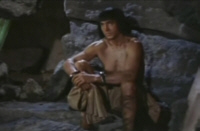 This comes to the fore with the arrival of Friday, played by Victor Lundin.
This being a science fiction film, Friday naturally needs to turn up in
suitably appropriate fashion, in this case as an escapee from a gang of
intergalactic slavers who are using his people to mine for ore on Mars.
Friday is a slave very much in the Egyptian model, with pleated skirt,
long black hair, and plenty of rippling muscles and pectorals. Since his
discovery of the crudely buried bones of a humanoid with a big ugly hole
in its head, Draper has worked on the assumption that he was no longer
alone on Mars and that his neighbours may not be friendly. He runs into
Friday when investigating the landing of what he thinks is a rescue ship,
but that turns out to be the slavers. This comes to the fore with the arrival of Friday, played by Victor Lundin.
This being a science fiction film, Friday naturally needs to turn up in
suitably appropriate fashion, in this case as an escapee from a gang of
intergalactic slavers who are using his people to mine for ore on Mars.
Friday is a slave very much in the Egyptian model, with pleated skirt,
long black hair, and plenty of rippling muscles and pectorals. Since his
discovery of the crudely buried bones of a humanoid with a big ugly hole
in its head, Draper has worked on the assumption that he was no longer
alone on Mars and that his neighbours may not be friendly. He runs into
Friday when investigating the landing of what he thinks is a rescue ship,
but that turns out to be the slavers. 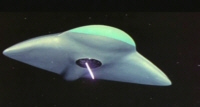 Friday has made a break for it, and
the slavers are blanketing the hills in a withering fire from their fighter
spacecraft, nasty manta ray styled vehicles that very much evoke the look
of the Martian war machines in The War of the Worlds. The big difference
is their speed, zipping from place to place like angry mosquitoes, unlike
the slow deliberate pace of Pal's war machines. It works very well,
imbuing them with a real sense of menace and power. Friday has made a break for it, and
the slavers are blanketing the hills in a withering fire from their fighter
spacecraft, nasty manta ray styled vehicles that very much evoke the look
of the Martian war machines in The War of the Worlds. The big difference
is their speed, zipping from place to place like angry mosquitoes, unlike
the slow deliberate pace of Pal's war machines. It works very well,
imbuing them with a real sense of menace and power.
There is a big shock coming when Draper gets his Friday home to his cave
and starts laying down the law, asserting his dominance over Friday in a
way that rather suggests the poor "savage" has left behind one set of masters,
only to gain a new one. The unpleasant vehemence of the moment is never
repeated, but we are treated to subsequent scenes of Draper lounging by his
underground pool while Friday potters around in domestic servitude and Draper
demands that he learn English. Yet writers Ib Melchoir and John C. Higgin
quickly wrong-foot the viewer, building a relationship between the two that
soon transcends the master-slave paradigm. When after Draper is buried and
nearly smothered beneath an ash fall, Friday rescues him, and Draper voices
his thanks not in English, but in Friday's Language. It's a lovely and
touching way to show that the dynamic of the relationship has changed, and
much for the better.
Both Mantee and Lundin bring considerable insight to their roles, aided by
a sophisticated script that constantly strives to surprise and challenge the
viewer. I always feel watching movies like this that the writers are well aware
of the inadequacies of their society and are striving to denounce this with
their writing, but that equally, as the products themselves of that society,
they are prone to inadvertently allow some of the shortcoming and prejudices
to creep in. I think you can especially sense that struggle in Robinson Crusoe
on Mars. The sixties were of course a time of great unrest in America (the
civil rights act had been enacted in 1964) and you can imagine if they had
cast a black man as Friday, just what an explosive film this could have been.
I think it entirely likely that the writers had the civil rights situation in
mind when writing the film. Of course despite the best efforts of the script,
there's that old "noble savage" idea lurking uncomfortably in the background,
but Lundin is clearly well aware of this and works hard to counter it in his
thoughtful portrayal of Friday. The script also takes pains to show that Draper
wants more than a subservient companion in Friday, and has Draper urging him at
one point to be his own person.
 The second half of the film becomes a less interesting extended chase, as
Draper and Friday descend below ground, following underground conduits that
mirror the Martian canals above. Of course, the canal theories of Percival
Lowell were at the time of the films making largely discredited, at least
so far as an artificial origin was concerned, (and as was subsequently
discovered, they never existed at all) but to the writers credit a geological
explanation is provided for. There is an interesting reference also here
to an earlier fight for freedom, when Draper comments that the caverns are
their underground railway, an idea that worked once and can work again.
Obviously this is a reference to the clandestine routes used by slaves in
the American civil war to reach free states. Eventually and despite constant
bombardment, the pair emerge unscathed at the polar ice cap and after a
suitably dramatic finale are found by a rescue ship from Earth. The second half of the film becomes a less interesting extended chase, as
Draper and Friday descend below ground, following underground conduits that
mirror the Martian canals above. Of course, the canal theories of Percival
Lowell were at the time of the films making largely discredited, at least
so far as an artificial origin was concerned, (and as was subsequently
discovered, they never existed at all) but to the writers credit a geological
explanation is provided for. There is an interesting reference also here
to an earlier fight for freedom, when Draper comments that the caverns are
their underground railway, an idea that worked once and can work again.
Obviously this is a reference to the clandestine routes used by slaves in
the American civil war to reach free states. Eventually and despite constant
bombardment, the pair emerge unscathed at the polar ice cap and after a
suitably dramatic finale are found by a rescue ship from Earth.
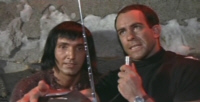 You can't help wonder though, how Friday is going to cope back on Earth.
Will he be the proverbial fish out of water, treated condescendingly by
polite society? It would be interesting to explore this idea, but better
yet I like to imagine the never made sequel to Robinson Crusoe on Mars,
in which Draper volunteers to ferry Friday home, only to crash on his homeworld
and discover that Friday is in fact from a civilisation far in advance of the
Earth. Draper then becomes in effect the savage, marooned far from home and
forced to learn the manners and niceties of interstellar society from a far superior race. You can't help wonder though, how Friday is going to cope back on Earth.
Will he be the proverbial fish out of water, treated condescendingly by
polite society? It would be interesting to explore this idea, but better
yet I like to imagine the never made sequel to Robinson Crusoe on Mars,
in which Draper volunteers to ferry Friday home, only to crash on his homeworld
and discover that Friday is in fact from a civilisation far in advance of the
Earth. Draper then becomes in effect the savage, marooned far from home and
forced to learn the manners and niceties of interstellar society from a far superior race.
In a bizarre postscript, there have been two songs recorded that were inspired
by Robinson Crusoe on Mars, most notably by Victor Lundin, who has enjoyed
somewhat of a varied career as both actor and singer. You can find the track
Robinson Crusoe on Mars on his album Little Owl. The singer/songwriter Johnny
Cymbal also recorded a song called "Robinson Crusoe on Mars" in 1964 which can
be found on the album The Very Best of Johnny Cymbal.
|
Buy
See also in:
Film & TV
|
1953
The War of the Worlds by George Pal. The action relocates to cold war America, with the Martian war machines re-invented as sinister flying machines.
|
|
1975
War of the Worlds TV Series by George Pal. Who knew that George Pal once planned a television series spin off from his 1953 movie?
|
|
1988
War of the Worlds An intermittently impressive TV series about a second Martian invasion of Earth.
|
Comics
|





